Falconry Facilities and Equipment
Guidelines for Minimum Requirements
General
The following Guidelines were developed by the Technical Advisory Committee of the North American Falconers'
Association (NAFA) for the purpose of insuring that facilities and equipment of prospective falconers meet
minimum acceptable standards. The inspection and approval of such facilities is a pre-requisite to being granted
a license to practice the sport. These guidelines are furnished to each applicant interested in a falconry
license to inform them of the standards by which their facilities and equipment will be judged. Wide variations,
especially in housing, may be expected. This brochure can hardly include descriptions of all acceptable systems,
however standards covering the more important aspects to be inspected and illustrations of basic principles
involved are presented. These are especially important in the case of the beginner. Where the more practiced
falconer chooses to make adaptations, such are based on experience, and so long as the basic principles are not
violated, such adaptations certainly are acceptable even though not specifically included here. Grateful
acknowledgement is given to the NAFA for the use of material which they provided.
Housing
A trained hawk's housing requirements are simple. The primary need is shelter from direct sun, wind, rain and
snow. Dryness, fresh air and an absence of drafts are also required and these are conditions that a wild hawk
seeks. The closer the falconer comes to providing the maximum levels of each, the more his hawks will benefit in
health and comfort. The quarters in which the hawk is to be kept, whether indoors (mews) and/or outdoors
(weathering area), is an area that is set aside exclusively for the bird(s).
- Indoor Facilities (Mews):
Mews may be a separate building or a room within a building. Ordinarily, sunlight and ventilation requirements make windows on the south or east exposures most desirable. The size of the mews varies with the species kept, but a room about eight feet high and square is appropriate for a raptor up to the size of a red-tailed hawk. In this sized area, the hawk may be kept loose or tethered to an appropriate perch.- Tethering is very much a matter of individual preference. It is preferable where more than one bird is kept and is normally mandatory where the sex and species of raptors kept in the same room are different. Accipiters (sharp-shinned, Cooper's and Goshawks) must never be placed free among other birds (including their own kind) as they may kill all others. Even when tied, the wise falconer provides separate mews or partitions the facilities for Accipiters to escape possible disaster in the even of escape. Raptors are generally tethered during training.
- The Interior of the mews should be plain with no beams or ledges available to tempt the hawk to fly to a higher perching place. It is a characteristic of birds of prey to seek higher perches from which to survey their surroundings. Anything that appears to offer a foothold above the hawk's rightful perch holds a hawk's attention. In a well-ordered mews, a hawk sits at ease when tethered because there is no other inviting perching place available.
- Windows should be protected on the inside by vertical bars or doweling spaced smaller than the bird’s width, even if birds are kept tethered in the mews. If screen or chicken wire is desired for additional protection or safety, it should be placed outside the vertical barring at sufficient distance to prevent a hawk from grasping the mesh and hurting themselves. This is also the reason that bars/dowels are placed vertically rather than horizontally. The mews should be capable of being darkened without interfering with overall ventilation, if fresh wild-caught birds are to be placed in it.
- Mews Doors should be externally secured (by lock if necessary) and have some sort of interior hook or spring so the falconer can keep the door safely closed while inside. Doors of any mews, which open directly out-of-doors, should be closed by an additional protective covering, inside or out, to prevent escape of a bird free in the mews (intentionally or otherwise) as the door is opened. Such protective covering can be achieved by a hanging cloth or plastic sheet. If the curtain is placed at an angle inside the mews, it provides the falconer with a small-enclosed alcove to step and loosen the outer door before pushing aside the cover to enter the mews itself.
- The Floor of the mews should be constructed to facilitate cleaning. A layer of gravel or sand is
excellent as these materials absorb moisture and must be washed occasionally for cleanliness. A covering
of straw, hay, sawdust, or similar material is not normally acceptable as these materials retain moisture
and provide a medium favorable for the growth of pathogenic fungi and bacteria dangerous to the bird's
health.
Although numerous variations in a captive raptor's housing may be appropriate under given circumstances, birdcages of the "pet-store-variety" or other such enclosures are totally unacceptable, as are any facilities, which do not afford the bird proper space and/or protection.
- Outdoor "Weathering" Facilities:
 Most falconers prefer to place their charges out-of-doors for sunning, etc. (called "weathering"),
if weather permits. In South Carolina, birds may be kept without a mew in outdoor facilities if conducted
properly and maintained. The birds are placed on appropriate perches (see below) on some soft, resilient
surface (e.g. a thick heavy lawn). This surface should be cleanable, or in the case of a lawn, the perch moved
frequently enough to prevent soiling the area beneath it. Soft sand should be avoided as it can get between
the bird’s legs and the jesses and cause skin abrasions. Perches must be located so birds are not exposed to
direct mid-day sun without shade being available. The size of the weathering facility is dependent upon the
length of the restraining leash. Each bird normally requires an area approximately eight-by-eight to
ten-by-ten feet to prevent its body or wings from touching the enclosing fence or other birds.
Most falconers prefer to place their charges out-of-doors for sunning, etc. (called "weathering"),
if weather permits. In South Carolina, birds may be kept without a mew in outdoor facilities if conducted
properly and maintained. The birds are placed on appropriate perches (see below) on some soft, resilient
surface (e.g. a thick heavy lawn). This surface should be cleanable, or in the case of a lawn, the perch moved
frequently enough to prevent soiling the area beneath it. Soft sand should be avoided as it can get between
the bird’s legs and the jesses and cause skin abrasions. Perches must be located so birds are not exposed to
direct mid-day sun without shade being available. The size of the weathering facility is dependent upon the
length of the restraining leash. Each bird normally requires an area approximately eight-by-eight to
ten-by-ten feet to prevent its body or wings from touching the enclosing fence or other birds.
Any site where birds are to be weathered must be protected to prevent attack by dogs, cats or other undue disturbance. For this reason a weathering site normally should be protectively fenced. Without such fencing, NO bird should be weathered unless under the immediate and continuous supervision of the falconer.
In many areas attacks by wild predators (mammals or birds) on falconers’ birds are not as uncommon as might be supposed, even in suburban areas. This is especially true of attacks by wild owls on birds left out-of-doors overnight. In areas where wild predators may constitute a problem, a totally enclosed weathering site (i.e., a site such as described above plus overhead protection in the form of wire or netting) becomes extremely desirable if not mandatory.
If mews are not provided, overhead wire is required for outdoor facilities. Overhead wire or netting must be high enough (6-7 feet) so the bird may not touch it when at the end of its leash and so the falconer can comfortably work inside the enclosure. As in any weathering site, the bird should not be able to touch the peripheral fencing or any other raptor in the same enclosure. NOTE: A bird is NOT placed free in such an enclosed weathering site but is tethered by leashes on normal outdoor perches (see below).
- Equipment
- Mandatory Prior to Acquisition of a Raptor
- Glove:
Some type of pliable leather glove is a necessity (one hand—usually the left—only). For smaller species of raptors a light leather gardening glove is sufficient; for larger species, an all-leather welder’s glove is appropriate. - Leash:
Varies in size and type depending on the species of raptor to be used. A thirty-inch leather bootlace is appropriate for a bird the size of a kestrel; a sixty-inch leather leash (1/4 to 1/2 inch wide, 1/16 to 3/32 inch thick or a 3/16 inch nylon cord with the ends burned to seal them) is adequate for a bird the size of a red-tailed hawk. A knot (called a "button") tied in the end is necessary to prevent the leash from slipping through the swivel. - Swivel:
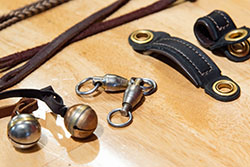 Several types of swivels are used. The classic "Figure 8" swivel
may be purchased from those manufacturing hawking equipment or a heavy-duty fishing swivel may be
used. The larger the bird, the larger the swivel that is required. The swivel is used to attach the
leash to the jesses and to prevent twisting of either or both. The commercial "snap" or
"dog leash" spring swivels should never be used in tethering a bird to an outside perch
because they cannot be trusted!
Several types of swivels are used. The classic "Figure 8" swivel
may be purchased from those manufacturing hawking equipment or a heavy-duty fishing swivel may be
used. The larger the bird, the larger the swivel that is required. The swivel is used to attach the
leash to the jesses and to prevent twisting of either or both. The commercial "snap" or
"dog leash" spring swivels should never be used in tethering a bird to an outside perch
because they cannot be trusted! - Jesses:
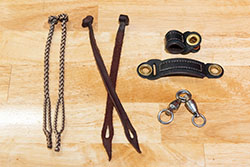 These are soft strips of tough, thin leather, one permanently fastened to
each leg of the captive raptor. Overall lengths of 4-6 inches for a kestrel or 8-10 inches for
red-tailed hawks are appropriate. Jesses are fitted and emplaced immediately upon receipt of any
raptor. "Aylmeri" jesses consists of a "cuff" and miniature leash for each leg.
The leather cuff is placed around the leg and its ends held together by a grommet. The miniature leash
is passed through the grommet and its slitted end is then attached to the swivel as are traditional
jesses. The use of "Aylmeri" jesses is encouraged. Not only are they more efficient, but an
escaped bird readily loosens (or removes) the miniature leashes, leaving it far less encumbered than
with traditional jesses.
These are soft strips of tough, thin leather, one permanently fastened to
each leg of the captive raptor. Overall lengths of 4-6 inches for a kestrel or 8-10 inches for
red-tailed hawks are appropriate. Jesses are fitted and emplaced immediately upon receipt of any
raptor. "Aylmeri" jesses consists of a "cuff" and miniature leash for each leg.
The leather cuff is placed around the leg and its ends held together by a grommet. The miniature leash
is passed through the grommet and its slitted end is then attached to the swivel as are traditional
jesses. The use of "Aylmeri" jesses is encouraged. Not only are they more efficient, but an
escaped bird readily loosens (or removes) the miniature leashes, leaving it far less encumbered than
with traditional jesses. - Bells:
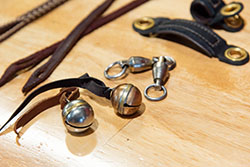 These are especially made for falconry and are small, light weight with a
loud tone. They must be purchased from those manufacturing hawking equipment (commercial
"Christmas jingle" bells are not suitable). Bells should be affixed immediately upon receipt
of a bird, either on the jess or with a small piece of leather called a "Bewit". Bells
provide a useful "signal" when something causes even an untrained raptor to move about
unduly. In the field, they assist the falconer in locating his bird when it is out of sight, and serve
to warn people that this is a captive bird. Normally two bells, each with a different tone, are used.
Bells for small species such as merlins, kestrels or sharp-shinned hawks are very difficult to obtain.
These are especially made for falconry and are small, light weight with a
loud tone. They must be purchased from those manufacturing hawking equipment (commercial
"Christmas jingle" bells are not suitable). Bells should be affixed immediately upon receipt
of a bird, either on the jess or with a small piece of leather called a "Bewit". Bells
provide a useful "signal" when something causes even an untrained raptor to move about
unduly. In the field, they assist the falconer in locating his bird when it is out of sight, and serve
to warn people that this is a captive bird. Normally two bells, each with a different tone, are used.
Bells for small species such as merlins, kestrels or sharp-shinned hawks are very difficult to obtain.
- Name-tag:
A small, light metal tag bearing, at a minimum, the owner's telephone number and normally name and address as well. Name tags should be attached to a jess or bewit and should be attached upon receipt of a bird in case of escape. The value of the nametag in retrieving lost hawks found by others cannot be overstressed. Some falconers place their names/telephone numbers, etc., on the hawk's bell(s) or on the jesses but this method is not nearly so likely to be noticed. - Bath Pan:
A large, shallow pan, tub or cut-down wooden barrel, 3-6 inches deep with a diameter several inches longer than the length of the bird (at a minimum). This provides both drinking and bathing water and should be cleaned and the water changed frequently (at least weekly and more frequently in hot weather). If the bird is kept free in the mews, the bath pan may be installed therein; otherwise the bath is provided outside when the bird is weathering. - Scales:
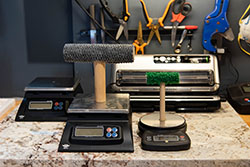 Traditionally, the falconer judges the hawk's condition by the amount of
flesh on its breast (sternum) and thighs. This judgment can be difficult to make especially for a
beginner. Additionally, a lean hawk may not be hungry and a fat hawk may, in fact, have an excellent
appetite. The falconer seeks the ideal medium between the two to keep his bird in the best condition.
The ideal and safest method of determining the amount of food given to achieve such condition is to
weigh the bird daily. Beam or balance (as opposed to spring) scales are preferred. Scales should
register in grams or l/4 ounce graduations.
Traditionally, the falconer judges the hawk's condition by the amount of
flesh on its breast (sternum) and thighs. This judgment can be difficult to make especially for a
beginner. Additionally, a lean hawk may not be hungry and a fat hawk may, in fact, have an excellent
appetite. The falconer seeks the ideal medium between the two to keep his bird in the best condition.
The ideal and safest method of determining the amount of food given to achieve such condition is to
weigh the bird daily. Beam or balance (as opposed to spring) scales are preferred. Scales should
register in grams or l/4 ounce graduations. - Outdoor Perches:
- Ring Perch:
This perch is used with birds that normally perch on tree limbs, i.e., the Accipiters and Buteos. The perching portion of the ring is a cross section of about one inch for small hawks and two inches for larger species. The overall diameter is generally about 12 inches. The portion the bird perches on should be covered with a fabric such as canvas or carpeting. - Block Perch:
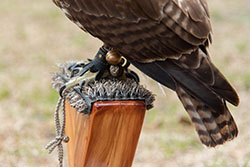 This type is used for falcons that normally perch on flat
surfaces. Diameters vary depending on the size of the bird but are normally from four to eight
inches. The top diameter must be sufficiently broad to prevent the two jesses from
"straddling" the perch or slipping over both sides simultaneously.
This type is used for falcons that normally perch on flat
surfaces. Diameters vary depending on the size of the bird but are normally from four to eight
inches. The top diameter must be sufficiently broad to prevent the two jesses from
"straddling" the perch or slipping over both sides simultaneously.
- Ring Perch:
- Indoor Perches:
- Screen Perch:
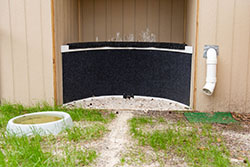 This perch is appropriate for use with all raptors used in
falconry and is the only perch described in this brochure suitable for use by more than one raptor
simultaneously. It consists of a horizontal bar with a strong cloth such as burlap has been
draped. This bar is fastened at chest height to the walls of the mews or to upright posts. The
cloth should hang down at least three feet on both sides of the bar and be fastened to a second
lower bar either attached to the mews walls/upright posts or swinging free. The upper (perching)
bar is normally padded with carpet and should be long enough to that the bird can reach neither
the ends nor any other birds tethered on it. Caution should be exercised in the use of this perch.
It should not be used for recently trapped or sick (weak) raptors and no raptor should be left
unattended on a screen perch until the falconer has ascertained that the bird is capable of
regaining the perch after attempting to fly from it.
This perch is appropriate for use with all raptors used in
falconry and is the only perch described in this brochure suitable for use by more than one raptor
simultaneously. It consists of a horizontal bar with a strong cloth such as burlap has been
draped. This bar is fastened at chest height to the walls of the mews or to upright posts. The
cloth should hang down at least three feet on both sides of the bar and be fastened to a second
lower bar either attached to the mews walls/upright posts or swinging free. The upper (perching)
bar is normally padded with carpet and should be long enough to that the bird can reach neither
the ends nor any other birds tethered on it. Caution should be exercised in the use of this perch.
It should not be used for recently trapped or sick (weak) raptors and no raptor should be left
unattended on a screen perch until the falconer has ascertained that the bird is capable of
regaining the perch after attempting to fly from it. - Round Perch: This perch is also suitable for all raptors. It is shaped very much like a large garbage can. As in all perches described, its size depends on the species of raptor for which it is intended. A goshawk uses a round perch about the size of a 55-gallon drum on end, with other species requiring proportionally smaller sizes. The sides and top rim (perch) are padded and the bird is tethered to a swivel arrangement in the center of a horizontal platform below the surface of the top of the perch.
- Shelf Perch: The shelf perch is most appropriate for falcons and normally consists of a shelf approximately 1 x 2 foot with a padded edge. All exposed edges and corners of the shelf must be rounded and smoothed so leash movement is not inhibited. The shelf is mounted projecting from an inner wall or inside corner of the mews. A shelf perch is normally used in combination with a block perch set in or on the mesh floor beneath to give the bird a choice of perches. The leash is tethered to the block in the normal fashion with length enough to allow access to the shelf. The leash then provides access to either the shelf or block but is not so long to become entangled around the block.
- Screen Perch:
- Glove:
- Mandatory Prior to Acquisition of a Raptor
- Optional Equipment
- Lure:
This is a padded leather device, ordinarily covered with the wings or fur of the intended quarry (a fresh individual of such quarry will also frequently suffice as a lure). The lure is used to call the bird back to the falconer after an unsuccessful flight or for exercise. It is garnished with meat attached by short strings (unless the actual quarry is used). A four to six foot line fastened to the lure allows the falconer to swing it in a large arc or circle, making it more visible and attractive. A raptor may or may not be trained to come to a lure. This method is recommended because it can be a safety measure because a raptor will often come to a lure when, for one reason or another, it is reluctant to come to the fist. - Hood:
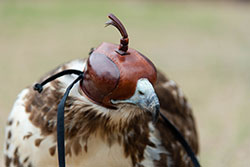 The hood is used to blindfold the raptor to keep it calm during handling and
transit. Hoods come in a variety of shapes and designs but the most important factor in any hood’s
suitability is its proper fit. The edges of the beak opening should not rub or chafe the soft parts
around the bird's beak, nostrils or mouth. The interior of the hood must not touch the raptor's eyes (as
revealed by moisture inside the hood when removed) and the portion of the hood passing under the
raptor's "chin" must not be so tight as to be constrictive.
The hood is used to blindfold the raptor to keep it calm during handling and
transit. Hoods come in a variety of shapes and designs but the most important factor in any hood’s
suitability is its proper fit. The edges of the beak opening should not rub or chafe the soft parts
around the bird's beak, nostrils or mouth. The interior of the hood must not touch the raptor's eyes (as
revealed by moisture inside the hood when removed) and the portion of the hood passing under the
raptor's "chin" must not be so tight as to be constrictive. - Food:
An adequate and reliable supply of proper food is as important as the considerations of shelter and equipment. Although the proper type and amount of food varies considerably with the species of raptor, the time of year and stage of the bird’s training, there are certain basic principles that apply in all cases. Natural food is the best food for any raptor and should make up the principal proportion of the diet. The best and most appropriate examples of such a natural diet are English sparrows, feral pigeons*, starlings, mice and rats. It is unlikely that the falconer can acquire unprotected birds or animals in sufficient numbers to provide a continuous and reliable supply, even for one hawk. (Caution: Ingestion of lead shot in birds or animals may cause lead poisoning in raptors.) Day-old cockrel chicks raised to 4-6 weeks old or Pharaoh/Coturnix quail may be raised by the falconer and are good replacements for natural foods. Such replacements should also be considered where unprotected wild birds and animals might contain dangerous levels of chemical sterilants, pesticides and/or other poisons. Supplemental foods such as butcher’s meat/chicken parts should be used only as a temporary expedient for the food items previously enumerated.
Vitamin and mineral supplements (such as Vionate, ABDec Drops, 1-a-Day tablets, etc.) are an important part of a captive raptor’s diet if non-natural food sources are used. Use of such supplements should be undertaken only after determining proper types and dosages from an experienced veterinarian (for example, some synthetic vitamins can prove harmful to raptors, as can some supplements containing iron).
- Lure:
*There is some question as to the advisability of feeding pigeons unless considerable care is exercised. Both wild and domestic pigeons are commonly infected with Trichomonas gallinae, a protozoan that causes a disease of the mouth and tongue in raptors that is frequently fatal and difficult to treat. Any pigeons used as food for captive raptors should have the head and crop removed and be allowed to cool for at least one hour (preferably longer) after death.
Back to Wild Birds of South Carolina
